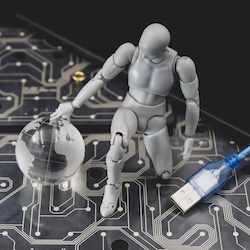
Technology now examines, diagnoses, and treats us.
The most precious asset of our being—good health—enjoys faster, better, and more accurate care as the marvels of data-driven devices complement the human touch of traditional medicine.
Take a look around you. Fitness wearables. Health apps on your smartphone. Remote sensors sending your vitals to care providers who can watch you from afar.
Behind it all is artificial intelligence, data computing, machine learning, and software engineering.
Yes, it’s a good time to be alive.
The times may be even better for healthtech itself because, as we consumers expect tech to ensure us better health, the global digital health market is projected to rocket to $500 billion by 2025. Consider, for example, how Amazon wants in.
Experts at the IEEE Computer Society have been not only chronicling these advances in healthcare but also offering new technologies to improve our well-being, especially for individuals who may have difficulty caring for themselves or even accessing a doctor or therapist.
Here are the highlights of their work and peer-reviewed research about the growing partnership between medicine and technology. They tackle some of the biggest issues facing physicians, such as offering wearable tech for patients suffering from age-related conditions, diabetes, mental illness, Parkinson’s, and Alzheimer’s. Others advance a global initiative on how to organize our personal health information and keep it secure. (Accessing studies from the Computer Society Digital Library may require a login.)
As the cost of healthcare skyrockets, nations increasingly look to revolutionary products and services in healthcare systems under what is called a new “digital health initiative.” The plan promises to save consumers and healthcare providers billions of dollars.
To do so, the initiative uses “extreme automation” to integrate thousands of healthcare systems, databases, programs, and apps into a seamless global network of fast, remote, highly specialized healthcare services.
Until recently, digital health apps and medical devices have been developed in “relative isolation from each other,” say Jinan Fiaidhi and Sabah Mohammed of Lakehead University.
But now, industry giants like Google and Apple are investing aggressively in integrated digital health by “turning data into action, improving patient health, promoting preventive care, enhancing patient engagement, providing advance care management, and contributing to the advancement of population health management,” add Fiaidhi and Mohammed, authors of “Digital Health in the Era of Extreme Automation.” (login may be required for full text)
In addition, thousands of smaller startups are developing apps to monitor health, manage chronic disease, and customize care plans. Some apps even offer patients the option of telecommunication health visits versus in-office patient visits.
The digital health initiative is moving to combine all of these efforts into a strong, integrated network of services.
The system will allow patients access to general sources of health information and their own records. Doctors and other stakeholders will also be able to access and share information among themselves to provide fast, efficient care to patients.
“The new automation model of digital health is based on collecting and connecting health-related data from all available sources, extracting meaningful information from that data, and providing that information to other healthcare stakeholders. Digital health assistive technologies also help patients access care more efficiently, delivering services where the patient is located when he or she needs it in a convenient manner,” the authors say.
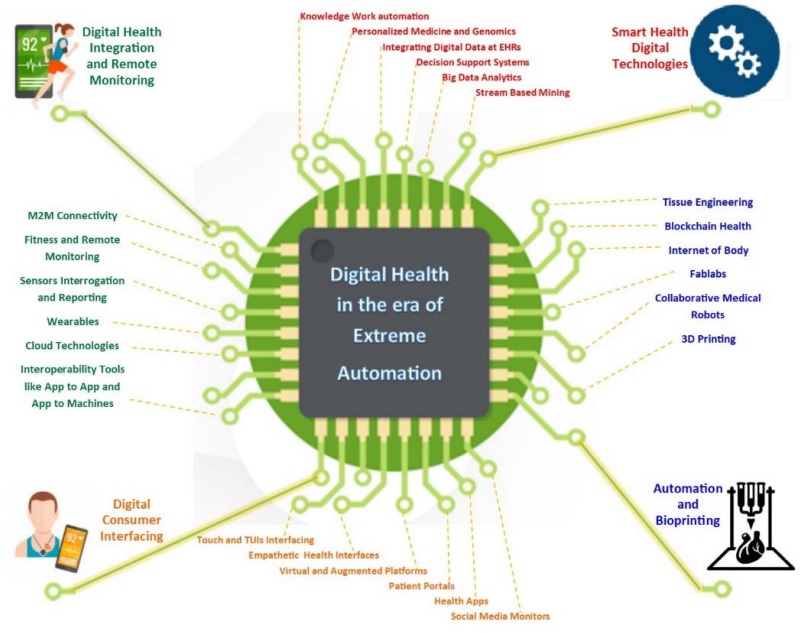
You are probably familiar with health and fitness apps and wearables that monitor your calorie intake, alcohol consumption, heart rate, temperature, steps taken, and so on.
They are all part of the Internet of Things.
The latest frontiers in digital health keep exploiting the IoT and other technologies:
A new era in healthcare management promises to improve care and bring down costs.
“With changes come new challenges and opportunities, as well as a dramatic shift in the competitive and regulatory landscape. We have only touched the surface of this exciting topic,” the authors conclude.
As diabetes threatens to become the biggest epidemic of the 21st Century, scientists have devised a datastream mining approach to computationally derive real-time decisions for type-1 diabetes therapy.
Computer scientists are calling their work a “new breed of computational methods” that is enabled by the datastream mining and is based on insulin prescription records and patients’ blood-glucose.
“Our model can assist healthcare experts in finding a suitable dosage and the correct timing of insulin administration based on decision rules so that the fluctuation of blood-glucose concentrations can be regulated to a stable level. The decision rules are patient-specific and can be applied to some personalized diabetic advisor, customized to a patient’s lifestyle and health requirements,” write Simon Fong, Jinan Fiaidhi, Sabah Mohammed, and Luiz A.M. Moutinho who co-authored “Managing Diabetes Therapy through Datastream Mining.” (login may be required for full text)
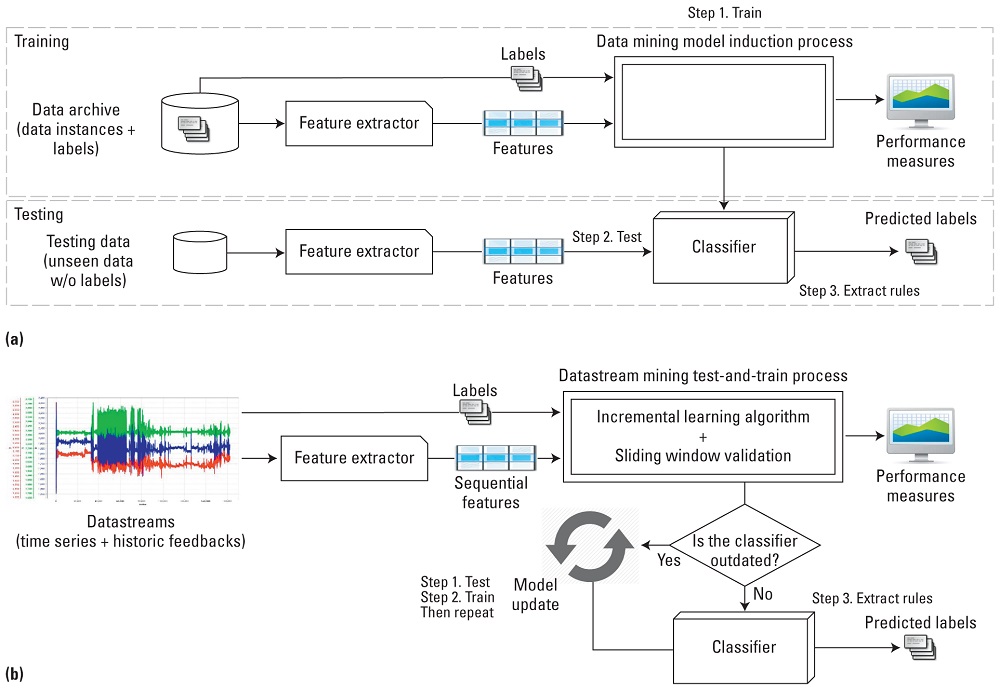
The authors conducted a computer simulation experiment for evaluating the most suitable datastream algorithms with respect to accuracy and speed. Out of six algorithms tested, two of them could reach an equilibrium of accuracy at high values—95.96 and 96.93 percent, respectively.
While the accuracy of the datastream algorithm matched that of traditional data mining methods, it exceeded those methods in one critical area—speed. When the threat of diabetic coma—subsequent death—looms large for all insulin-dependent diabetes patients, time is of the essence.
For the roughly 450 million people worldwide who suffer from serious mental illness, a new sensing technology proposal promises some relief.
Wearables and smartphones may soon be able to help people with depression, bipolar disorder, schizophrenia, suicidal thoughts, and other disorders by monitoring their activity, physical symptoms, and social interactions for early signs of trouble.
“Serious mental illnesses often don’t have life-long cures; however, appropriate intervention and management can ensure long-term patient well-being. Effective illness management requires granular symptom monitoring. Specifically, identifying early-warning signs in patients can result in timely clinical interventions and, thus, prevent relapse onset and hospitalization,” say Saeed Abdullah of Penn State University and Tanzeem Choudhury of Cornell University in their article “Sensing Technologies for Monitoring Serious Mental Illnesses.” (login may be required for full text)
Abdullah and Choudhury propose a new sensing technology system that uses wearables and smart phones to capture a variety of behavioral, physiological, and social data related to serious mental illnesses. The chart below details the sensing methods, types of technology required, data features, and the types of patients most helped by the method.
But there is more to be done before sensing technologies become a reality and an integral part of mental health care, according to Abdullah and Choudhury.
“Before these technologies can be fully integrated into existing healthcare infrastructure, we must address numerous key challenges, including the lack of clinical evidence, integration of multi-modal data streams, privacy issues, and long-term user engagement. Successful integration of sensing technologies has the potential to reshape mental health care—making it preemptive, patient-centered, and cost-effective while extending its reach to a global population,” they say.
Recently, an international team of scientists completed an information and communication technology system that uses smart devices, the Internet of Things (IoT), and imaging sensors to help people with Parkinson’s and Alzheimer’s live more independent lives.
The analysis of data collected allow early detection and prevention of health problems.
The system includes data capturing and multi-modal fusion to extract relevant health information, analyze data, and provide useful recommendations.
“The system gathers signals from diverse sources in health monitoring environments, understands the user behavior and context, and triggers proper actions for improving the patient’s quality of life,” say the authors of “Behavior Analysis through Multimodal Sensing for Care of Parkinson’s and Alzheimer’s Patients.” (login may be required for full text)
This system architecture, depicted below, consists of three layers: a services subsystem, a high-level subsystem, and a low-level subsystem. The services are oriented to gather other subsystems’ information and present the relevant information to the actors involved. 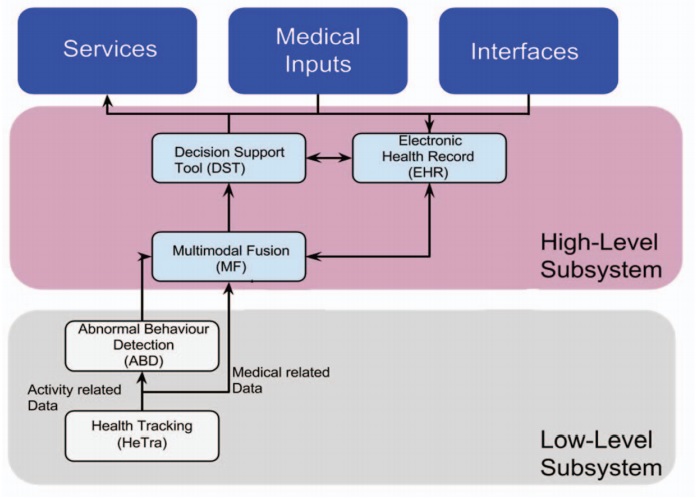
The illustration below shows the interconnection of all the sensors in the system. The multi-sensorial app integrates real-time data, allowing for synchronization and organization of the sensory measurements.
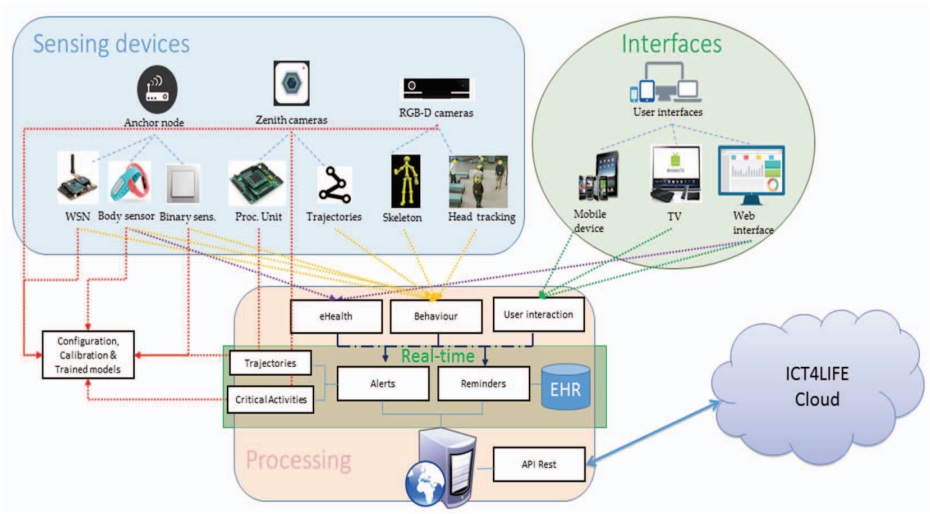
The illustration below shows how all the devices are calibrated in a common spatial coordinate system.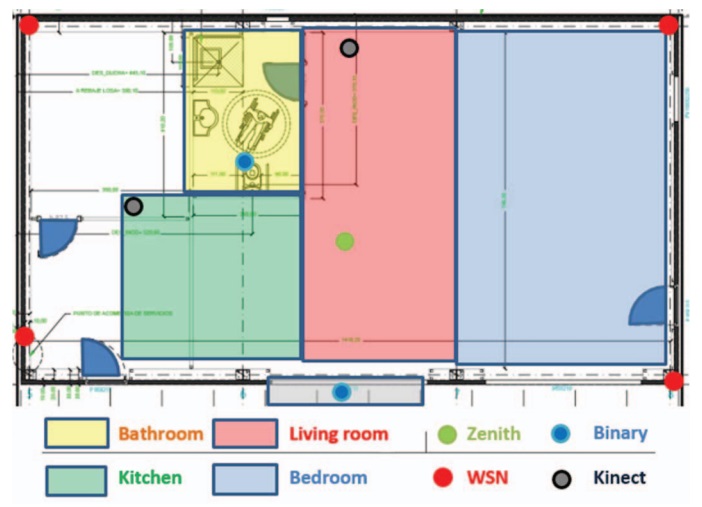
“The process consists of three steps: selecting a common coordinate system (manual), obtaining the rotation and translation matrix for the cameras, and performing the calibration for the WSN using the mentioned reference system,” the authors say.
An illustration of “freezing of gait” (FoG) detection is shown below.
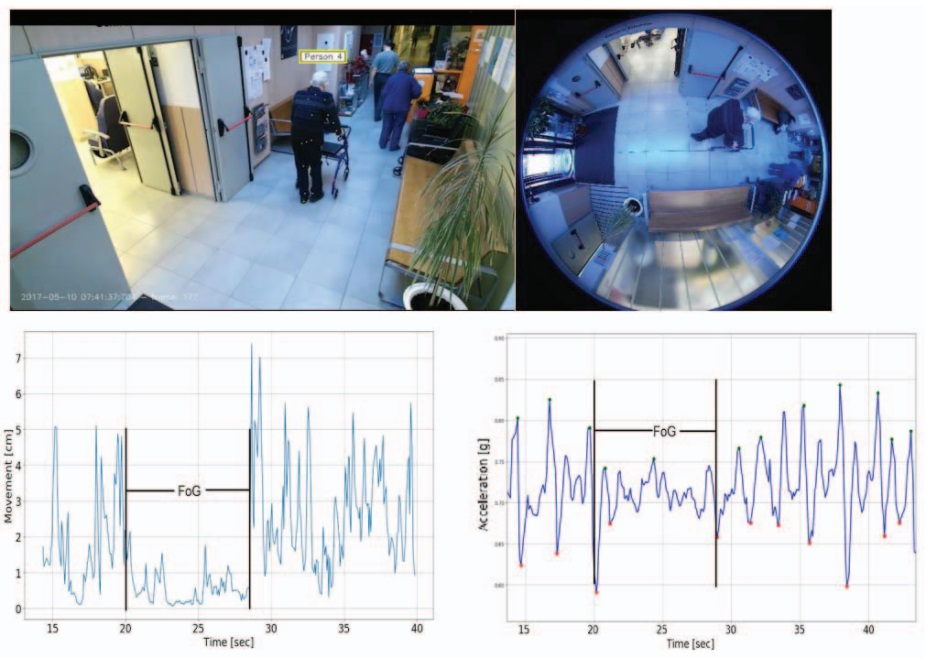
“FoG refers to a state in which a patient with Parkinson’s disease experiences a sudden lack of movement despite his or her willingness to move. It typically occurs in specific situations, such as when starting to walk, stepping through a doorway, attempting to turn a corner, or approaching a chair. It typically lasts a few seconds, and it is very important to be detected, because FoG episodes are unpredictable and greatly increase the chance of falling. Furthermore, an increase in FoG episodes needs to be reported to the physician,” say the authors.
In the illustration below, data was recorded while patients were walking back and forth in a straight line, a random manner, and through rooms.

“In total, 8 hours and 20 minutes of data was recorded, containing more than 200 recorded freezing incidences,” say the authors.
One of the most important features of the system is that it can analyze patient behavior accurately even with limited information from just a few sensors.
“The multimodal fusion techniques presented here guarantee the modularity of the entire system by allowing its operation even in cases where not all presented sensors are available. This offers the versatility to identify different activities and events related to the evaluation of the patient’s health status. The results are promising compared to other works,” the authors say.
The authors of this work are Federico Alvarez, Gustavo Hernández-Peñaloza, Marcos Quintana, and Alberto Belmonte-Hernández of Universidad Politécnica de Madrid; Mirela Popa, Stylianos Asteriadis, and Dario Dotti of Universiteit Maastricht; and Vassilios Solachidis, Nicholas Vretos, Thomas Theodoridis, and Petros Daras of the Centre for Research and Technology, Hellas.
A new design for an app would allow physical therapists to remotely monitor an elderly person’s gait and physical health status and then allow them to remotely intervene and provide therapies to the elderly person so that he or she can overcome any risk of falling.
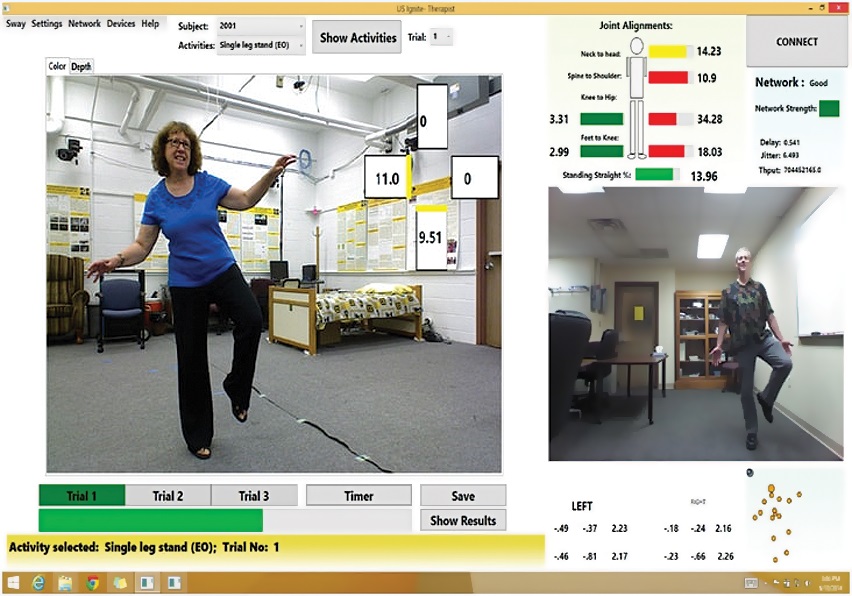
The technology is especially designed to provide eldercare in rural and sometimes suburban areas where travel times to a medical office can be very long, according to University of Missouri-Columbia scientists who wrote a study entitled “Toward an ElderCare Living Lab for Sensor-Based Health Assessment and Physical Therapy.” (login may be required for full text)
The Mizzou team includes Prasad Calyam, Isa Jahnke, Anup Mishra, Ronny Bazan Antequera, Dmitrii Chemodanov, and Marjorie Skubic.
Those long distances are a significant hurdle for many patients seeking care.
Their article presents a design for an “ElderCare-as-a-SmartService” (ECaaS) system that integrates apps for in-home health monitoring and remote physical therapy coaching.
Blockchain, the technology underlying the boom in cryptocurrency, is now being considered for a more intimate use—your medical and health records.
Already, a good many of your medical records sit in the cloud, placed there by doctors’ offices and hospitals—saving on data management costs, providing speedy access, and even saving lives.
However, it exposes your private information to hackers and other security threats. Conventional security measures are proving inadequate.
Blockchain, the standard-bearer for secure online financial transactions and ranked No. 3 in the Computer Society’s top 10 tech trends to watch in 2018, could be an answer to those threats.
What’s unclear is whether it would be cost effective and legally feasible. Concerns also exist over how blockchain keeps records in ledgers forever—enough to give pause about your health records—and whether blockchain can handle huge medical files, say computer scientists from the University of Salerno, University of Hong Kong, and University of Texas at San Antonio.
“The privacy and integrity of healthcare data must be protected not only from external attackers, but also from unauthorized access attempts from inside the network or ecosystem (e.g. employee of the healthcare provider, or cloud service provider). The attacks (e.g. leakage or modification of data) can be intentional and unintentional, and organizations may be penalized or held criminally liable for such incidents, for example under the Health Insurance Portability and Accountability Act,” say Christian Esposito, Alfredo De Santis, Genny Tortora, Henry Chang, and Kim-Kwang Raymond Choo, authors of “Blockchain: A Panacea for Healthcare Cloud-Based Data Security and Privacy?” (login may be required for full text)
The Internet of Things creates potential risks, especially with wearables and other sources acquiring personal data.
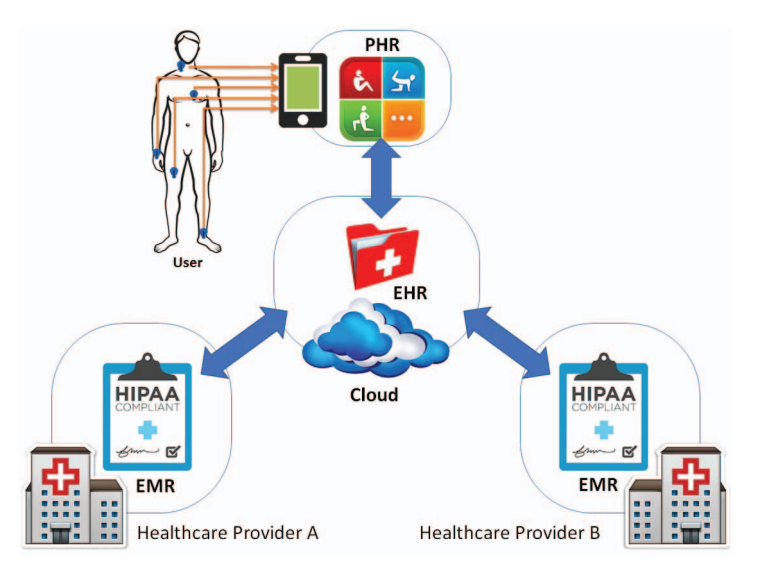
“Recently, the pervasiveness of smart devices has also resulted in a paradigm shift within the healthcare industry. Such devices can be user-owned or installed by the healthcare provider to measure the well-being of the [patients] and inform/facilitate medical treatment and monitoring of patients,” the authors say.
To find out how blockchain can keep our medical information private, we must first know how it works.
A blockchain is a digital ledger of verified transactions locked together chronologically in an encrypted chain. The ledger is updated with new transactions every few minutes, allowing each computer to access the same current shared ledger.
The chain of transactions in a block is encrypted so that, in order to tamper with a document in the block, hackers would have to tamper with ALL the transactions in the block.
It’s hard to do without getting caught.
Read previous research on “The Blockchain Mystery: Three Things You Should Know”
In addition to financial transactions, blockchain can secure and verify any personal, legal, and business document—wills, trusts, patents, contracts, notarizations, marriage certificates, death certificates, anything.
Add to that list: medical records.
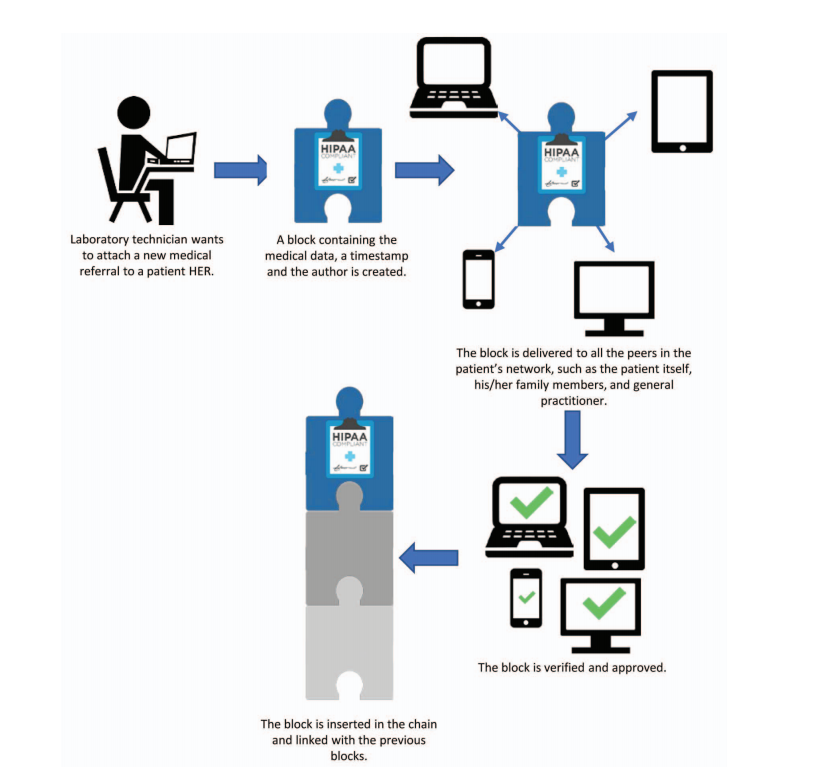
“When new healthcare data for a particular patient is created (e.g. from a consultation, surgery), a new block is instantiated and distributed to all peers in the patient network. After a majority of the peers have approved the new block, the system will insert it in the chain. This allows us to achieve a global view of the patient’s medical history in an efficient, verifiable, and permanent way,” the authors explain.
